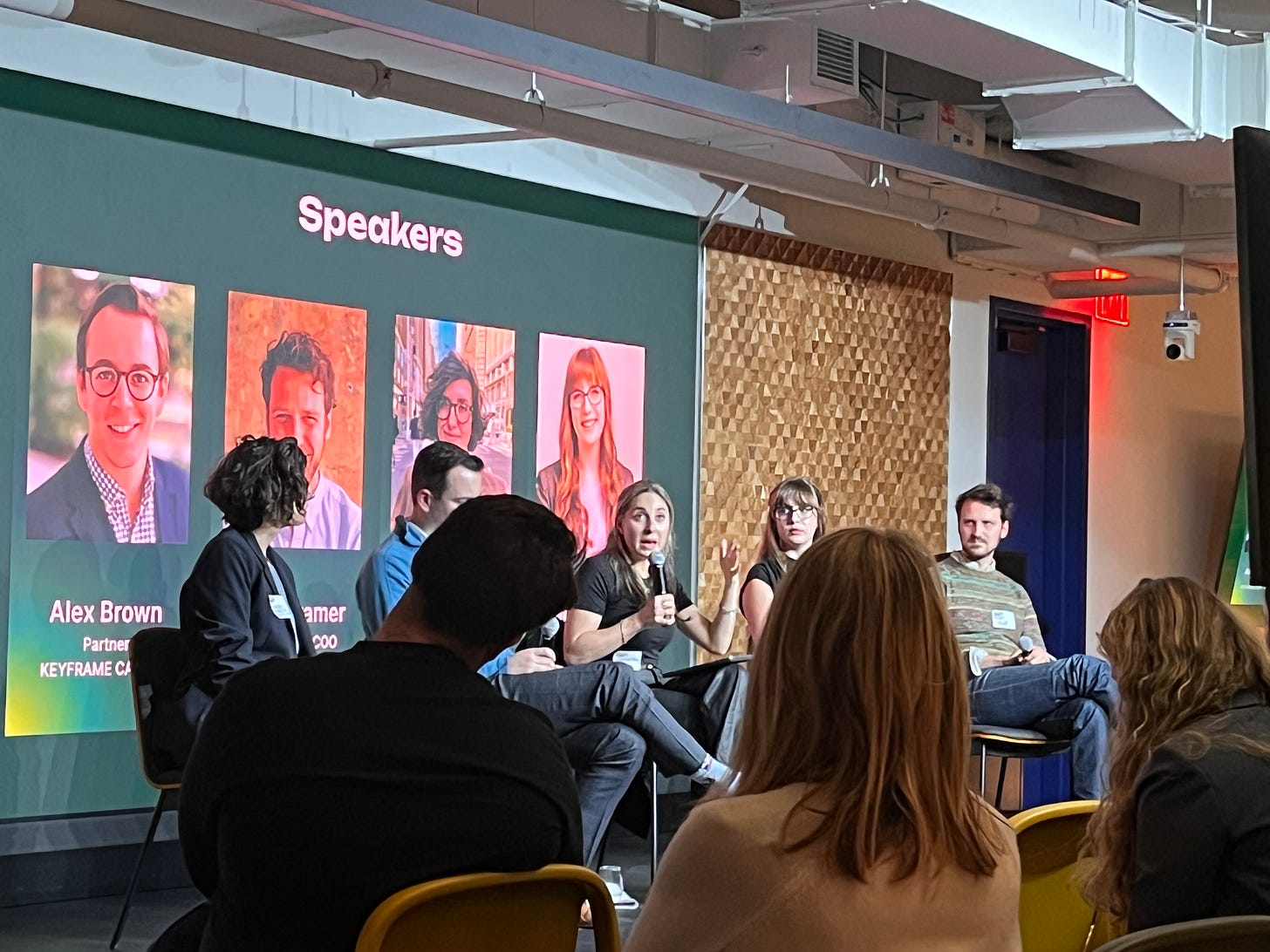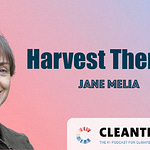🌎 Welcome back to the CleanTechies PodLetter, founder edition. Today we are talking about the Recommerce.
Again, let us know if you want to see anything in particular in these longer-form write-ups as we are still iterating.
Let’s get into it.
What you’ll find in today’s PodLetter…
Diverting Hardware from Landfills to In-Need Organizations
Complex Logistics as a Moat
Bootstrapping 🥾
The Rigatoni List 🍝
Advice to Founders:
Talk to Lots of People and Make Your Own Thoughts
Show Notes
Carveouts
📺 Watch on YouTube
🍎 Apple Podcasts
🎧 Spotify
🗣️ Join the Slack Channel
💡 Diverting Hardware from Landfills to In-Need Organizations
As the tech boom and PC revolution took off, not much attention was given to the end of life for all this hardware. In many cases, companies were having their interns take a hammer to their hard drives and other devices. Hardware that still had life left.
Frustrated by bureaucracy and slow-moving corporate jobs, John Fazzolari and Anthony Serina decided to do their own thing. They eventually stumbled on this repurposing hardware industry. At the time, it was totally novel.
They were able to get solid traction quickly because tech companies, being innovative, also saw the hammer solution as wasteful. Fast-forward 10 years, they have been serving customers for a long time, have learned a lot, and are now considered to have been “In Climate before it was cool”. To them, they were just working on something they saw in need of a solution and trying to make a positive impact on the world.
Complex Logistics as a Moat
Revivn uses logistics as a moat to defend its business from others by making it difficult for competitors to replicate their complex and efficient systems. Revivn has spent years developing its logistics network, which includes relationships with a variety of partners, such as trucking companies, warehouses, and recyclers. This network allows Revivn to collect, transport, and process electronic waste quickly and efficiently. It would be very difficult for a new company to replicate this network, giving Revivn a significant competitive advantage.
Part of their moat is the amount of data they have compared to anyone who would enter the market today. Some of this data is tracked and analyzed but a lot is also in the experience of the team themselves. This should serve as a reminder to founders that in many cases, patience and pure persistence can be a moat factor. Of course, if you’re pursuing this route, you may need to reconsider taking on Venture funding as they don’t exactly have the patience for that.
In addition to this, they have a highly scalable setup. Due to relationship building, a strong track record, and maniacal attention to the customer experience their partners provide, they have the ability to easily add new partners and locations to their network, which allows them to grow their business quickly. This scalability makes it difficult for competitors to keep up with Revivn.
So, if you're thinking of competing with Revivn, think again. Their logistics moat is deeper than the Mariana Trench and harder to cross than the Swiss Alps. However, you too could learn from this and approach your startup in the same way.
Bootstrapping 🥾
When we talk about the moat of time + relationships + good customer experience, none of this is possible without one special ingredient. That is one that has become sexy lately, but in many cases, is totally impractical — yep, the dirty ‘b word’ … Bootstrapping.
Given they were working on hardware at a time when it was super popular as a VC investment (not) they were forced to bootstrap.
The benefits to bootstrapping were they were able to focus on building a good business and were able to take their time doing it. It also forced them to focus on profitability early.
There are downsides to this as well. Mainly the difficulty of it. There is no cushion and you need to make it work. John’s sentiment was summarized when he referenced the recent Acquired interview with NVIDIA CEO Jensen Huang. The pain and suffering of building a company is already hard enough, much more so when you bootstrap.
So, for founders in the early days, consider the benefits and difficulties of bootstrapping. Keep in mind again, that not all Climate businesses need to be venture funded. An argument can be made that if you don’t need venture dollars, you should leave them for the firms that do.
If you are going to raise, John says to only raise as much as you absotlutely need to in order to hit your next milestone. If you’re raising in an up market, you may struggle the next round and have to get repriced.
“…you really want to raise as little as possible to hit the next milestone so that you stay profitable or force yourself to get to profitability and then find product market fit. Because if you can do that a little bit at a time, then you can still control your own destiny and have optionality. …over the past few years… a lot of companies raise that valuations that unfortunately they will never grow into.”
🚨🚨🚨 Attention Hiring Managers!!! Are you struggling to find qualified candidates? Maybe getting candidates but can’t bring them across the line consistently? Or not getting sufficient applicants? — Reach out to our sponsors NextWave Partners today to help solve that for you.
NextWave Partners is a leading Global Renewables, Climate, & Sustainability recruitment consultancy solely focused on these impact areas. They are also B-Corp Certified.
Reach out to them today to help you solve your hiring challenges and get you one step closer to making an impact.
The Rigatoni List 🍝
In addition to operational complexity, a key part of their success is relationships and hiring.
John cares deeply about the customer experience and ensures that their partners do as well. If an individual in the team of one of their partners is not upholding their values, they make sure to get them switched out quickly.
This focus on experience really stems from the value he puts on connection. This also bleeds into hiring. John has something he calls the Rigatoni list. This is a list of cool people and it’s dynamic. There are people who he’s only spoken with once, people who he catches up with every couple of months, and he keeps it fresh.
This ends up helping with hiring because when the time comes, he may have a well-established connection with the right person for the job.
By not focusing only on transactional interactions and spending time with people in the context of long-term relationships, he’s building a lot of goodwill. While this may seem quite simple, it’s also a widely overlooked aspect of building a good business (startup or otherwise).
🚀 Advice to Founders
Talk to Lots of People and Make Your Own Thoughts
One of John’s main pieces of advice was to develop your own thoughts through a higher volume of conversations. If you speak with a lot of people on a variety of topics, it will help you form your own perspective as long as you’re willing to spend a bit of time thinking.
This is important because without this we can easily fall into group think. Being able to think independently, and therefore out of the box, is an important skill for building a startup.
📝 Show Notes:
Topics
2:20 Intro to John
3:00 Why the un-used hardware space
4:05 Creating the Category
6:05 The Story of How They Built
7:35 How they work
9:10 Cost Savings
12:20 Logistics - Their Moat is Complex Coordination
14:45 How to scale logistics company business
16:10 How to control customer quality experience
18:45 Examples of their impact
22:00 Why they bootstrapped
23:55 Advice on Fundraising
27:10 Advice on Hiring | The Rigatoni List
30:00 How to understand if someone has potential
31:58 Advice to Young Entrepreneurs in Climate
34:38 Other Ideas
Links
Revivn.com
For all your Climate, Renewables, and Sustainability recruitment needs, check out our sponsor NextWave Partners.
This podcast is NOT investment advice. Do your homework and due diligence before investing in anything discussed on this podcast.
🚨 Carveouts:
Somil
This week, I had the opportunity to attend a panel in NYC hosted by SOSV program IndieBio about the Climate Capital Stack. A huge shoutout to them and Climate Hack for putting on a great panel bringing VC, green banks, and founders all in one room to provide a range of necessary perspectives.
At this panel, although it was a niche topic, there were still many people there who were looking to get into climate and wanting to learn more about the space and how they could potentially transition one day. This made majority of the conversations at the networking portion were about how I found myself getting into climate, rather than discussing the topics discussed at the panel. These conversations are still great and can still lead to serendipitous connections, but it lacked digestion of the material discussed — which was fantastic btw.
This made me think about how if we or others put on an event 😉, some guided networking/discussion for the audience could be useful after the panel to make sure that connections are being made not only naturally but over the content discussed. That would greatly amplify the learning opportunity.
Silas
There have been two items that have come up in conversations lately that I wanted to share.
The ‘ew don’t touch Oil & Gas’ mentality mostly exists among software climate companies. I made a post about this on LinkedIn, and a pretty good amount of engagement ensued.
My takeaway is still, we need to include the oil and gas companies in the journey of solving climate change. Will they likely continue operating for a while yes, but it isn’t reasonable to expect them to turn off the tap abruptly. If we don’t eventually show them that the green future is not just greener for the environment but also for their wallets, we will end up having a long, drawn-out battle where stones are hurled and the crux of the problem will not be solved.
Let’s work together in a way that does not incentivize long term usage of oil. The dollars from oil into climate are all very helpful, and so are those pilot projects.There is an emerging focus on companies that are collecting climate data that is not currently available elsewhere. There will be some BIG winners in this space over the next few years. The investments will happen likely within the next 3-5 months but in ~3-5 years watch this space.
One final carveout I wanted to make is for the IDIC (Industrial Decarbonization Innovation Challenge) hosted by Centrepolis Accelerator. They are an amazing set of accelerators working on Industry 4.0. They have incredible partners and will invest money into some winners.
The deadline was extended to December 8th so if you’re a hardware climate founder, apply today!



















Share this post